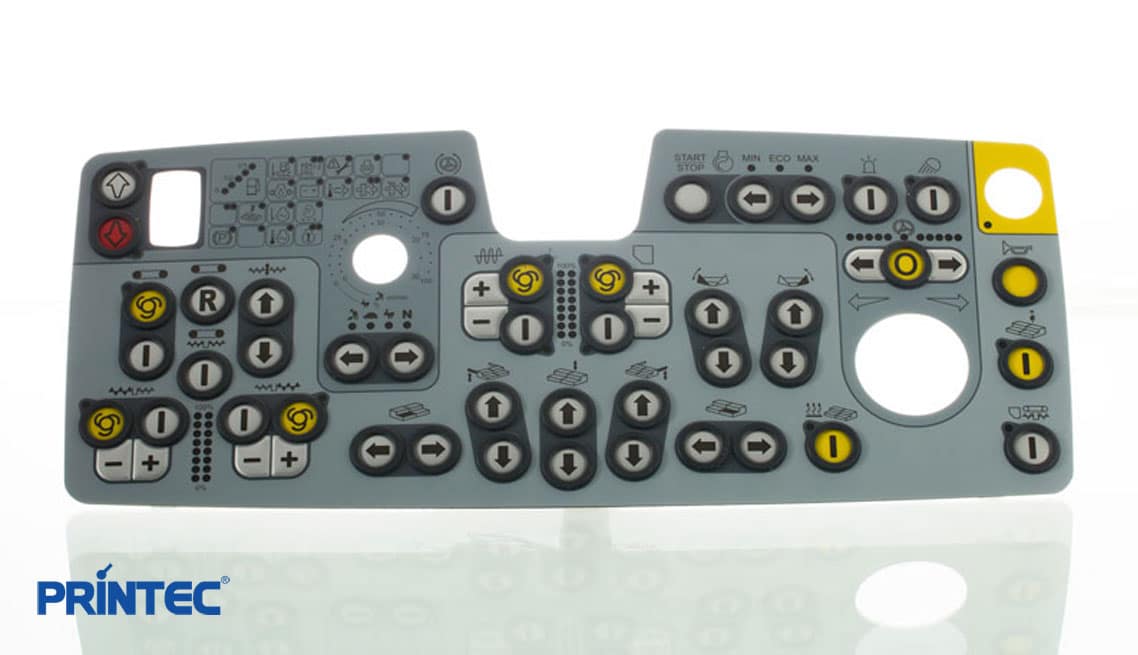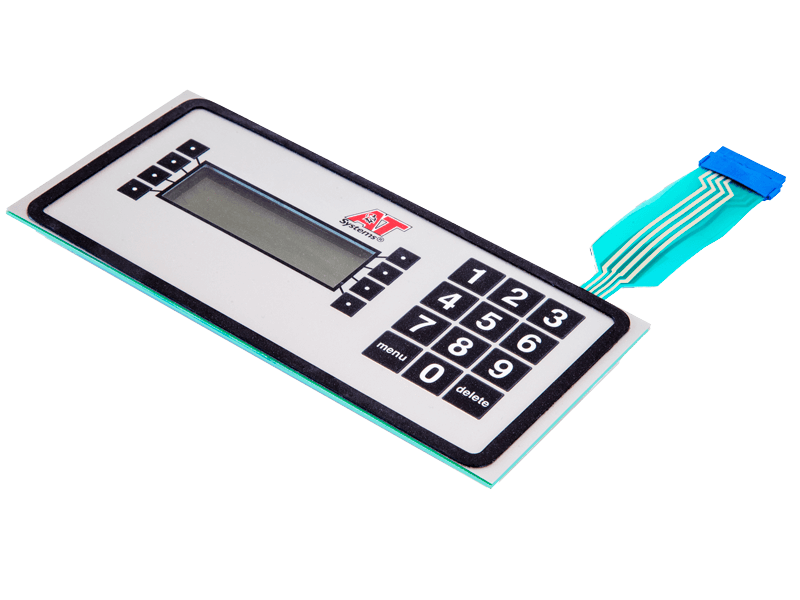Discover the Adaptability and Longevity of Membrane Switches in Modern Electronics
Discover the Adaptability and Longevity of Membrane Switches in Modern Electronics
Blog Article
Membrane Layer Switches Explained: A Comprehensive Guide to Their Advantages
Membrane switches stand for a sophisticated and flexible solution for creating individual interfaces across a variety of sectors. As industries significantly seek reliable and efficient control interfaces, understanding the particular advantages and applications of membrane changes becomes crucial.
What Are Membrane Layer Buttons?

When pressure is put on the membrane layer switch, the layers make get in touch with, finishing an electric circuit. This basic system allows for a vast array of applications, from consumer electronics to industrial machinery. Membrane layer buttons are often developed to be water resistant and resistant to dust and pollutants, making them ideal for settings where resilience is crucial.
Additionally, the versatility of the materials made use of in membrane layer changes promotes ingenious layouts that can adapt numerous shapes and measurements. This flexibility contributes to their appeal in varied areas, consisting of medical tools, automobile controls, and home appliances. Generally, membrane layer changes stand for an essential component in modern-day customer interface modern technology, bridging the void between users and electronic systems.
Secret Advantages of Membrane Layer Switches
Among the myriad of interface options readily available, membrane switches stand apart for their unique mix of benefits. Among the key advantages is their compact and lightweight style, which permits for combination into a vast array of devices without including considerable bulk. This is especially beneficial in applications where area is limited.
Furthermore, membrane layer switches over deal longevity and resistance to ecological variables. They are generally created with products that can withstand wetness, dust, and different chemicals, making them appropriate for extreme problems. This longevity adds to a much longer life-span contrasted to conventional mechanical switches.
Another substantial benefit is the versatility in personalization. Membrane switches can be published with various graphics, shades, and appearances, enabling tailored layouts that meet specific branding or useful demands. This flexibility reaches the variety of layers and circuit alternatives, supplying engineers with several arrangements.
Additionally, the responsive comments provided by some membrane switches enhances user experience, making them more intuitive to run. The convenience of cleaning and upkeep even more strengthens membrane buttons as a practical choice in both customer and commercial applications. Generally, these crucial advantages make them a recommended solution for several designers and manufacturers
Applications in Different Industries
Exactly how do membrane switches find their place across diverse industries? Their convenience and functionality make them important elements in industries ranging from healthcare to consumer electronic devices. In clinical gadgets, membrane switches are made use of for their ease of cleansing and resistance to contamination, ensuring hygiene in settings where sterility is essential.
In the customer electronic devices sector, these switches supply smooth, easy to use interfaces that enhance item aesthetic appeals while maintaining sturdiness against wear and tear. Automotive applications gain from membrane switches also, where they are utilized in control panels and control panels, using trustworthy efficiency in tough problems.
Furthermore, industrial equipment utilizes membrane layer buttons for control panels due to their toughness, capability to hold up against extreme environments, and personalized styles that cater to details operational needs. The food market leverages membrane layer switches for their convenience of use and resistance to spills, ensuring operational performance in hectic settings.
Inevitably, the adaptability of membrane layer switches throughout these varied applications emphasizes their important duty in contemporary technology, improving individual communication while satisfying industry-specific requirements. Their proceeded advancement assures additional integration right into arising areas and ingenious products.
Layout and Personalization Choices
The design helpful hints and modification options readily available for membrane buttons are critical for customizing interfaces to meet details customer demands and aesthetic preferences. These buttons can be developed in numerous shapes, dimensions, and designs, allowing for smooth integration right into diverse applications. The flexibility in style indicates that suppliers can develop distinct interfaces that improve use and preserve brand identification.
Customized graphics, shades, and appearances can be applied to the surface area of the membrane switch, offering an opportunity for branding and customer involvement. Furthermore, backlighting choices, such as LED illumination, can be integrated to enhance visibility in low-light problems, thus improving performance.
Useful elements can also be tailored, including tactile responses and actuation pressure, which can be gotten used to match different user communications. The selection of materials, such as polyester or polycarbonate, enables variants in longevity and environmental resistance, catering to the certain needs of different sectors.
Ultimately, the extensive design and customization capabilities of membrane switches enable firms to develop user-friendly and aesthetically appealing user interfaces, making sure that their items fulfill both practical and aesthetic needs properly. Membrane Switches.
Considerations for Application
Implementing membrane switches over needs careful factor to consider of numerous factors to ensure optimum capability and customer experience. Among the main factors to consider is the designated application atmosphere. Variables such as direct exposure to wetness, severe temperatures, and chemical materials can substantially impact the switch's efficiency and durability. Selecting materials that stand up to these problems is crucial.

One more important try this aspect is the button's style and design. Ensuring that the responsive responses and actuation force line up with individual assumptions enhances functionality. Carrying out customer testing can provide valuable insights right into the optimum style.
Additionally, compatibility with electronic components must be assessed. The switch's circuitry need to line up with the total system style, ensuring reputable signal transmission and decreasing interference.
Moreover, manufacturing approaches and expenses ought to be evaluated. The option between custom-made designs and typical versions can influence both budget plan and lead time.
Finally, think about repair and maintenance. Membrane switches might need details cleansing and treatment treatments to keep their appearance and performance in time. By dealing with these factors to consider, organizations can implement membrane layer switches that satisfy their functional requirements while supplying a positive customer experience.

Conclusion
In verdict, membrane switches stand for a functional and long lasting control user interface appropriate for a wide array of applications across numerous sectors. Membrane Switches. As innovation continues to evolve, the importance of membrane layer switches in modern-day devices stays substantial, offering both functionality and aesthetic appeal.
Membrane switches stand for a functional and sophisticated remedy for developing customer interfaces throughout a selection of industries.Recognizing the essential elements of modern-day digital interfaces, membrane buttons are a kind of individual interface device that are composed of versatile, slim layers of product. In general, membrane switches over stand for a crucial aspect in contemporary customer interface technology, connecting the space between users and digital systems.
Among the myriad of user interface alternatives offered, membrane layer switches over stand out for their discover this info here special combination of benefits.The style and personalization alternatives offered for membrane buttons are vital for customizing interfaces to meet details customer requirements and visual preferences.
Report this page